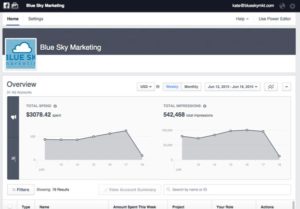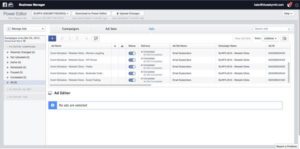 Facebook soft-launched a new tool called “Business Manager” in late 2014 that intends to allow these high-octane brand/business users to track those activities all in one place — Business Manager. What’s more, they’ve been rolling out many new changes to their Ad Accounts structure and tools to give advertisers more insights into audiences so we can be more strategic in our targeting. Here are a few different tools that I’ve come to rely on in creating and optimizing campaigns for our clients’ Facebook advertising campaigns.
Facebook soft-launched a new tool called “Business Manager” in late 2014 that intends to allow these high-octane brand/business users to track those activities all in one place — Business Manager. What’s more, they’ve been rolling out many new changes to their Ad Accounts structure and tools to give advertisers more insights into audiences so we can be more strategic in our targeting. Here are a few different tools that I’ve come to rely on in creating and optimizing campaigns for our clients’ Facebook advertising campaigns.
Create An Audience for Your Best ROI
Custom & Lookalike Audiences – Retargeting + Discovery
Many marketers that have dabbled with Facebook advertising know the basics about boosting posts to Page Fans, but there is a lot more to Facebook’s targeting that I’ve really found success in using – specifically retargeting website visitors, in-house email or phone lists as well as creating lookalike audiences based on Page Fans and even website conversions.
This can be done via the the “Audiences” area of the Ad Account and creating Custom Audiences. You can upload a CSV file of emails or phone numbers of your prospects and Facebook will connect that data with the profile associated with that email or phone number. Retargeting based on website visits requires a pixel to be installed on your site. These audiences are good for reaching out to prospects familiar with the brand with follow-up messaging.
Lookalike Audiences can then be created based on website visitors, conversions or prospect lists to target new audiences with similar profiles to your lists. These audiences are sometimes a bit more of a long-shot, but are good for finding new customers with general brand messaging.
Strategic Retargeting with Facebook Ads
Social ads have often been considered a discovery medium for brands, but I would also argue that they are an effective retargeting/remarketing tactic as well. With simply setting up a pixel on your website and creating a campaign of follow-up messages, you can maximize frequency of your message to your target audience. For example, you are running a Google AdWords search and display campaign or even an email to a third party list, which successfully converts to a website visit. With a simple website tracking pixel (and updated privacy policy) in place, you can retarget any of those interested consumers with a follow-up message to invite them back to the website — turning a warm lead into an even warmer one.
Tip: Create a funnel of messages with website retargeting. General branding messages to capture interest, then retarget with more specific messages to drive them back to key converting pages on your website.

Campaign Development – Test, Test & Test Again
The key to any good online campaign is testing and the same can be said for Facebook campaigns. Here are a few recommendations for setting up the base for successful testing as well as optimizing your campaigns for the best CTR or CPM:
- Don’t Forget Website Analytics – be sure to set up Goals on your site if you don’t have them already and use tracking code on your Facebook ads’ URLs to track which are converting the best. This will help you in determining which audiences are performing the best and even which messages drive more leads, sales, etc.
- Always Create Multiple Versions of an Ad – Facebook’s platform is set up to optimize for your campaign objective, so creating multiple versions of the same ad will help test which resonates most with your target audience so that you can get the best CTR as well as increasing frequency of message with a fresh look later. Tip: Using their Power Editor is a great tool for quickly creating multiple versions.
- Get Creative with Target Audiences – the beauty of the amount of self-reporting that happens on Facebook is that advertisers can target based on Interests as well as Demographics. Facebook has also partnered with three of the top data collection companies to incorporate additional Behavior targeting as well as many other Demographic targeting from data that isn’t self-reported. Be aware though that using targeting methods tied to that third party data will come with a higher price tag per click/impression. Makes sense, right? Facebook has to pay for that data, so costs get pushed through to advertisers.
- Go Big or Go Home – Most marketers want to zero in on what they consider a highly probable group for conversions by selecting many criteria and limiting their audience size. This drives your CPC/CPM up. Target a bit more loosely to see a lower cost per thousand served. Generally speaking, targeting an audience of less than 20,000 will be much more expensive per thousand. Over 100,000 is where you start to see economic pricing.
- Monitor Frequency & Cost – If you are using all four placements for your ads – newsfeed desktop and mobile, third party app placements and desktop right column, you’ll want to stay below a frequency of 4. Facebook just recently added a column called “Relevance Score” stealing from the Google AdWords playbook to give you a quick read on how effective your ad is. They say that the score doesn’t affect your CPM, but is more of an indicator of success or unsuccessful targeting.
Both Twitter and LinkedIn are monitizing their newsfeeds as well as Pinterest and soon Instagram. Our team at Blue Sky Marketing are always early adopters and love to roll up our sleeves and test for the best ways to use these online marketing tools. Read our other blogs about our recent trips to the ClickZ Conference in NYC, Google All Stars Event or the Facebook Fit Event.
If you are interested in improving your presence on Facebook or other social platforms, Blue Sky Marketing can help. See more of our online marketing services and contact us today.
Article originally posted on Blue Sky Marketing Blog: https://blueskymarketing.wordpress.com/
by Kate Nilsen, Blue Sky Marketing